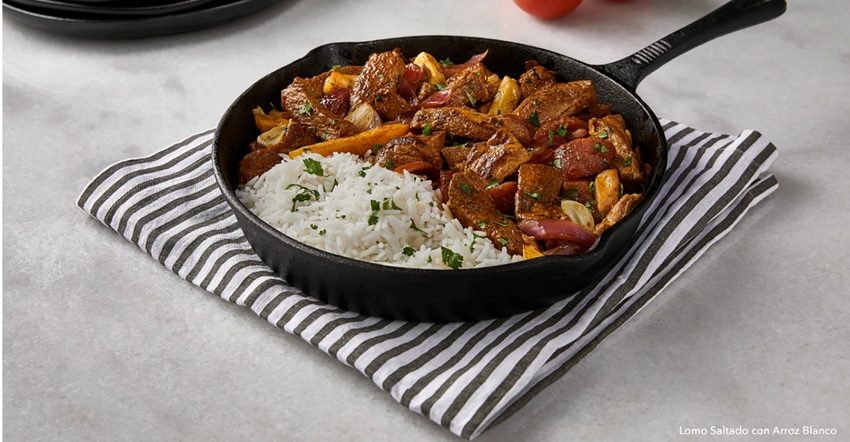‘Time to Tango’ taps into Hispanic pork consumers
New research identifies steps for retailers and packers to seize once-in-a-generation opportunity.
October 2, 2019

Considering that National Pork Month coincides with Hispanic Heritage Month, it is appropriate that the National Pork Board declares that it is “Time to Tango.”
Though both monthly designations are a reason to celebrate, the “Time to Tango” actually refers to an NPB report showing U.S. Latinos’ affinity for pork and growing purchasing power make it a critical audience for the industry, but as Hispanics acculturate, their pork consumption declines. The new report, Time to Tango: Latinos are Pork’s Future, reveals steps food retailers and packers must take to connect with these influential consumers who represent the biggest growth opportunity of the next several decades.
The report is the latest in the NPB’s Insight to Action research program examining key behaviors, attitudes and cultural nuances of U.S. Hispanic shoppers. It outlines top motivators for Hispanics when selecting their preferred retailer and protein choice.
“Pork is entrenched in Hispanic heritage and culture, and extremely relevant to the fast-growing and economically powerful Hispanic segment,” says José de Jesús, director of multicultural marketing for the NPB. “The pork industry must proactively engage them and better meet their needs, otherwise we risk losing the Latino consumer.��”
According to the report, as Hispanic consumers become acculturated in the United States, the link between pork and culture weakens. Often, they can’t find the cuts they want for traditional dishes in mainstream stores, so they use other proteins or shop at specialty stores that offer the service to deliver the cuts they want. Nearly half (49%) of Hispanics do not choose mainstream retailers as their go-to store, and instead opt for specialty stores, ethnic markets and bodegas. The meat case is a contributing factor — 44% of Hispanics choose to buy their fresh meat at non-mainstream grocery stores.
To maintain and increase loyalty among Hispanic consumers, the report outlines three key motivators retailers and packers must address.
Accessibility: Most (79%) Hispanic consumers shop with someone else in their family and seek out stores that offer a family friendly experience. More than half seek out stores offering specialty cuts. Therefore, the shopping experience and value must meet Latinos’ expectations, and the cuts and preparations they want need to be more easily available in mainstream stores.
Authenticity: Traditional family recipes are important to Hispanic consumers, but those traditions vary by the country of origin. What’s relevant to the Cuban or Puerto Rican consumer will be different than those from Mexico or Central American countries. While two of three Hispanics in the United States are originally from Mexico, a third are from other nations. A “hyper-local” strategy is best and should extend beyond the meat case. Having the right cuts available is key, but also offering the seasonings, spices and ingredients that are needed to complete those traditional pork dishes is just as important.
Health: Nearly two-thirds (63%) of unacculturated Hispanics mistakenly believe pork is unhealthy. The industry must focus on the nutritional value of specific cuts, including pork’s protein profile.
“The food industry is changing rapidly; foresight and adaptability are the keys to survival. U.S. Hispanics spend $95 billion a year on consumer packaged goods and their purchasing power is growing,” says David Newman, a pig farmer and president of the NPB. “It’s no longer enough to offer a Hispanic aisle or packaging in Spanish. We need to look at each area of the store and ensure we’re meeting Hispanic consumers’ needs.”
The report is the first in a series of reports, articles and updates the NPB will provide in the months ahead to help the food industry better respond to Hispanic consumers’ needs. The NPB has also developed a free marketing toolkit that includes content and information for retailers and packers to leverage in their own communications channels. Click here to access the full report, and more information about the NPB’s Insights to Action research.
About the research
The NPB commissioned custom research with C+R Research and Datassential. The multi-phased custom studies included a variety of qualitative methodologies including focus groups, in-depth interviews, shop-alongs and dine-alongs, as well as surveyed 11,000-plus consumers, including more than 2,000 Hispanic consumers, and paired foodservice operator interviews, volumetric data and syndicated foodservice data to gain a comprehensive, in-depth look at the needs, offerings, considerations and motivations that impact Hispanic dining decisions.
Source: National Pork Board, which is solely responsible for the information provided, and wholly owns the information. Informa Business Media and all its subsidiaries are not responsible for any of the content contained in this information asset.
About the Author(s)
You May Also Like



